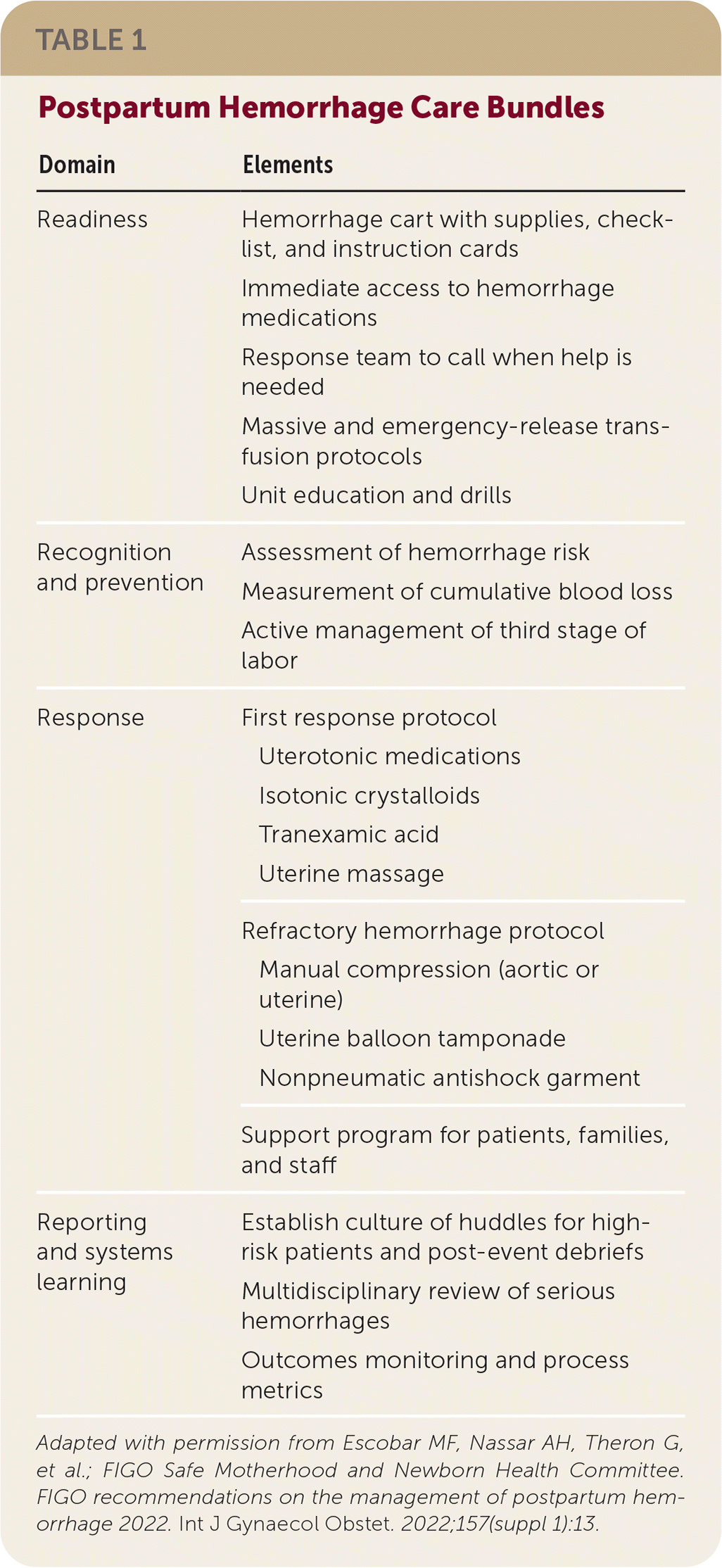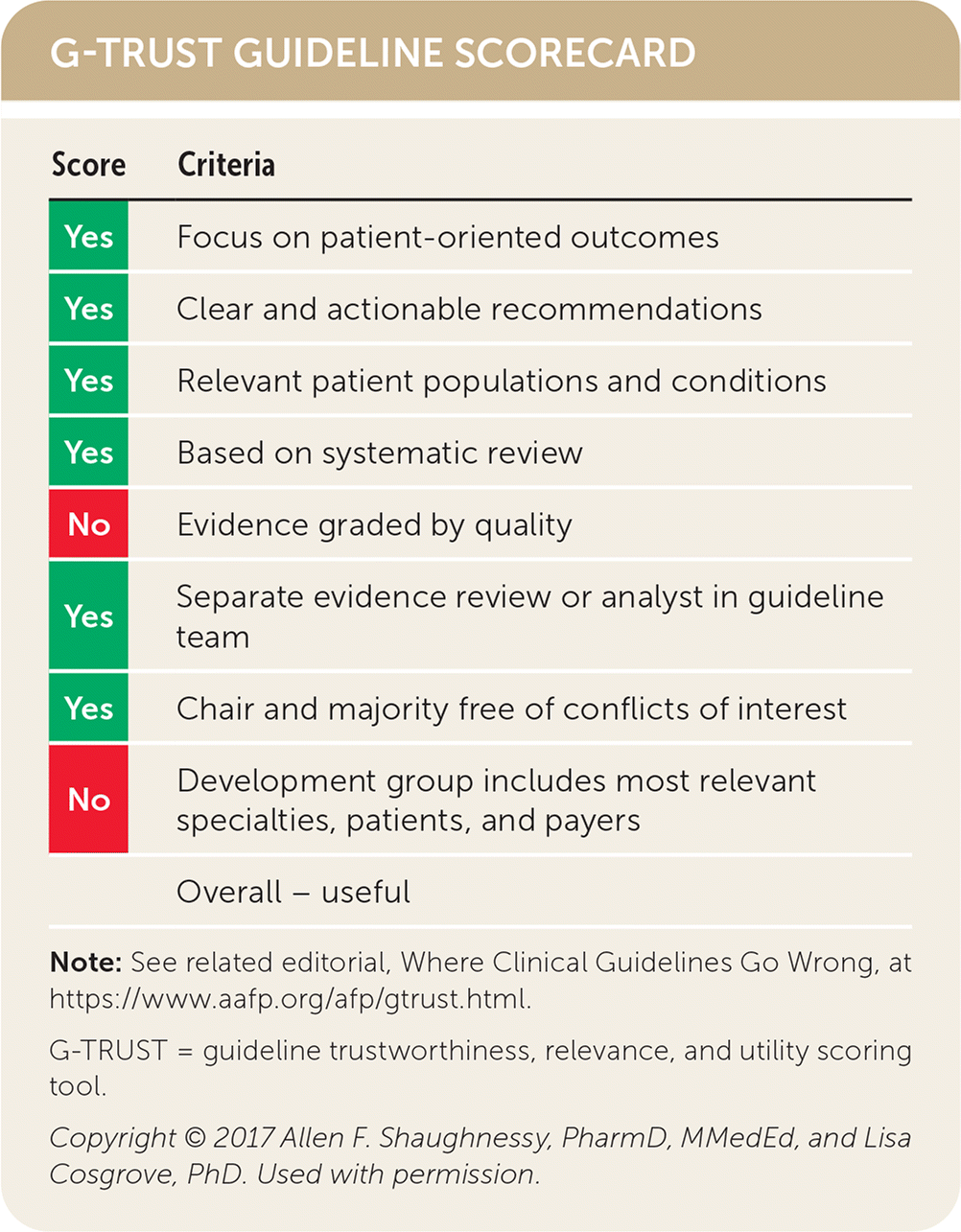
Am Fam Physician. 2023;107(4):438-440
Author disclosure: No relevant financial relationships.
Key Points for Practice
• Oxytocin given between delivery of the infant and the placenta is the most effective intervention to prevent postpartum hemorrhage.
• Tranexamic acid given within three hours of vaginal delivery after 500 mL of blood loss reduces mortality by up to 30%.
• Uterine balloon tamponade prior to shock controls more than 80% of postpartum hemorrhage cases that do not respond to initial interventions, and it can confirm the uterus as the source of bleeding.
• The nonpneumatic antishock garment provides lower body compression to increase cardiac function in postpartum hemorrhage, and it reduces maternal mortality by nearly one-half.
From the AFP Editors
Although definitions vary, the American College of Obstetricians and Gynecologists defines postpartum hemorrhage as blood loss of at least 1,000 mL or blood loss accompanied by signs of hypovolemia within 24 hours of delivery. Postpartum hemorrhage complicates up to 1 in 10 deliveries and is the leading cause of maternal morbidity and mortality worldwide. Despite many identified risk factors of postpartum hemorrhage, most cases occur unexpectedly. The International Federation of Gynecology and Obstetrics (FIGO) published new guidelines for the prevention and management of postpartum hemorrhage.
Prevention
The most important intervention for preventing postpartum hemorrhage is administering uterotonic medications such as oxytocin between delivery of the baby and the placenta. Although oxytocin is primarily used alone, combining it with ergometrine (i.e., methylergonovine [Methergine] in the United States) or misoprostol (which may also be used alone if oxytocin is not available) may be more effective than oxytocin alone, but both combinations are associated with more adverse effects. Sustained uterine massage is not recommended in women who have received oxytocin.
Causes
The causes of postpartum hemorrhage match the four Ts that are included in most instruction:
Tone – decreased uterine tone or atony (70%)
Trauma – birth canal injury (20%)
Tissue – retained placenta or uterine clot
Thrombin – any coagulation issue
Despite many identified risk factors of postpartum hemorrhage, most cases occur unexpectedly.
Treatment
SAFETY BUNDLES
Postpartum hemorrhage safety bundles are standard response actions to deliver a consistent and systematic response to obstetric hemorrhage. These bundles cover four domains that are recommended for readiness, recognition and prevention, response, and reporting and systems learning (Table 1).

| Domain | Elements |
|---|---|
| Readiness | Hemorrhage cart with supplies, checklist, and instruction cards Immediate access to hemorrhage medications Response team to call when help is needed Massive and emergency-release transfusion protocols Unit education and drills |
| Recognition and prevention | Assessment of hemorrhage risk Measurement of cumulative blood loss Active management of third stage of labor |
| Response | First response protocol Uterotonic medications Isotonic crystalloids Tranexamic acid Uterine massage Refractory hemorrhage protocol Manual compression (aortic or uterine) Uterine balloon tamponade Nonpneumatic antishock garment |
| Support program for patients, families, and staff | |
| Reporting and systems learning | Establish culture of huddles for high-risk patients and post-event debriefs |
| Multidisciplinary review of serious hemorrhages | |
| Outcomes monitoring and process metrics |
INITIAL INTERVENTIONS
Postpartum hemorrhage treatment is directed toward the cause of bleeding and incorporates a stepwise approach starting with the simplest and least invasive interventions. Initial response includes uterine massage, placement of two large bore intravenous catheters, supplemental oxygen, strict monitoring, crystalloid isotonic fluid infusion, and avoidance of hypothermia.
ASSESSING FOR SHOCK
Vital signs are unreliable for recognition of shock because changes occur late after high-volume blood loss. The shock index is a ratio of heart rate to systolic blood pressure. A shock index of 0.9 or greater is associated with increased mortality, and a shock index of greater than 1 increases the likelihood of blood transfusion.
The rule of 30 is another tool for estimating severe blood loss. A drop in hematocrit of 30%, a drop in hemoglobin of 30%, a drop in systolic blood pressure of 30 mm Hg, and an increase in pulse by 30 beats per minute all suggest a blood loss of 30%.
TRANEXAMIC ACID
Tranexamic acid inhibits fibrinolysis and can reduce mortality by up to 30% in postpartum hemorrhage. It is recommended for all women with blood loss of at least 500 mL after vaginal delivery or 1,000 mL of blood loss after cesarean delivery. It should be administered as 1 g infused intravenously over 10 minutes, within three hours of delivery. A second dose can be given for continued bleeding 30 minutes following the first dose.
Nonsurgical Management
UTERINE BALLOON TAMPONADE
With uterine balloon tamponade, a balloon is placed into the uterus and filled with saline to tamponade uterine bleeding. It is diagnostic and therapeutic, in that stopping bleeding verifies an intrauterine source. Uterine balloon tamponade is recommended for refractory bleeding despite treatment with uterotonic medications and tranexamic acid. In studies, uterine balloon tamponade used before the onset of advanced shock results in excellent outcomes—less than 1 in 5 patients needs further interventions, and mortality is near zero.
NONPNEUMATIC ANTISHOCK GARMENT
The nonpneumatic antishock garment is a set of lightweight neoprene sleeves that compress the lower body to improve cardiac output without blocking access to the vagina. This device can be used to stabilize the patient before definitive surgical management, transfusion, and transfer to a higher level of care. Use of a nonpneumatic antishock garment reduces maternal mortality by 48%.
Surgical Management
Surgical management techniques are pursued when conservative therapies are unsuccessful in stopping bleeding from the uterus. In centers with interventional radiology services immediately available, uterine artery embolization is at least 90% effective and likely to preserve future fertility. Uterine compression sutures are the simplest surgical intervention, can be performed in addition to uterine balloon tamponade, and have a 92% success rate in studies. Uterine artery temporary ligation is successful about 40% of the time, as is bilateral internal iliac artery ligation, although the risk of damage to the external iliac arteries and ureters limits use. Peripartum hysterectomy can be definitive but has high morbidity. Damage control resuscitation is used for patients who may not survive definitive surgical repair and can include blood products and surgical stabilization procedures.
Supportive Care
BLOOD PRESSURE TARGET
Until major bleeding has been controlled, the target systolic blood pressure should be between 80 and 90 mm Hg, and the mean arterial pressure between 50 and 60 mm Hg.
MASSIVE TRANSFUSION PROTOCOLS
Massive transfusion refers to the administration of four or more units of packed red blood cells within 24 hours. Massive transfusion protocols enable continued release of blood products in the correct ratio to optimize hemostasis.

| Score | Criteria |
|---|---|
| Yes | Focus on patient-oriented outcomes |
| Yes | Clear and actionable recommendations |
| Yes | Relevant patient populations and conditions |
| Yes | Based on systematic review |
| No | Evidence graded by quality |
| Yes | Separate evidence review or analyst in guideline team |
| Yes | Chair and majority free of conflicts of interest |
| No | Development group includes most relevant specialties, patients, and payers |
| Overall – useful |
The views expressed are those of the authors and do not necessarily reflect the official policy or position of the U.S. Department of the Navy, U.S. Department of Defense, or the U.S. government.
Guideline source: International Federation of Gynecology and Obstetrics
Published source: Int J Gynaecol Obstet. March 2022; 157 (suppl 1): 3–50
